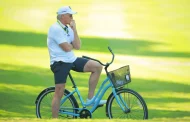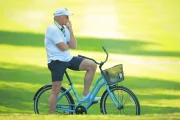They saved the best, the absolute best for last Wednesday evening at the World Golf Hall Of Fame — and that would be Sam Alexis Woods as presenter and her famous father, Tiger (his ownself) Woods as the inductee.
Sure, Susie Maxwell Berning, Tim Finchem and the late Marion Hollins had their moments and Renee Powell delivered an incredible message as recipient of the first-ever Charlie Sifford Award. But it was The Great One they were waiting for. The upstairs seating area was lined with players from the PGA Tour. Tiger’s buddy Justin Thomas sat right behind him.
They waited for the last one. Sam was outstanding, her father was brought to near-tears and delivered a message of an upbringing and personal drive and passion that delivered a career that thus far has 82 Tour wins and 15 major championships, three U.S. Amateur crowns.
Tiger also delivered a message as to why most don’t make it in professional golf.
“I had a burning desire to express myself in this game of golf,” Woods declared. He also expounded on his upbringing by Vietnam era Special Forces soldier, his father Earl and Tiger’s mom, Kultida, a native of Thailand.
“One of the things that Dad had instilled in me is that he grew up in an era, same era as Charlie Sifford and why my son is named after Charlie, is that you had to be twice as good to be given half a chance,” said Woods during his acceptance speech that lasted right at 15 minutes. “So that understanding and that drive, as Sam said, train hard, fight easy. I made practicing so difficult, hurt so much, because I wanted to make sure that I was ready come game time. I hit thousands of balls, hands bleeding, aching, just so that I could play in a tournament.”
Special Forces mantra — train hard, fight easy. Navy Seal mantra: Bleed in training so you don’t bleed in combat.
“You’re given nothing, you earn everything,” Woods emphasized. And that’s lost in today’s upcoming generation. Tiger had an old school upbringing. His first golf footsteps were on a public par-three — Hartwell in Long Beach. He began to sneak onto the Navy Golf Club in San Diego where his father played. You had to be 10 to play as a junior. He snuck on at age eight, often hid in a ditch on the course until Earl would locate him late in the afternoons when he got off work.
As he grew in age and skill level, Tiger began to play Southern California junior golf.
“Southern California Junior Golf Association had amazing tournaments throughout the summer. We’d play all these great golf courses. Now meanwhile, you have to understand, I only played Heartwell or snuck on the Navy golf course,” Woods recalled. “So one of the neatest things in the world for me was to play on a golf course as I read the name of the golf course and it had the two letters afterward, CC.
“So I was going to go play a country club. We had these fresh greens, not these bouncy poa greens that’s all over the place where they’re cut probably twice a week. I’m going to get a chance to play fresh greens. Well, playing at some of these golf courses, I was not allowed in the clubhouses where all the other juniors were. The color of my skin dictated that. As I got older, that drove me even more. So as I was denied access into the clubhouses, that’s fine. Put my shoes on here in the parking lot. I asked two questions only, that was it. Where was the 1st tee, and what was the course record? Not complicated.”
By the time he reached age 14, Earl and Kultida had to make a big decision. The American Junior Golf Association (AJGA) was the place to be seen by college golf coaches and it was and is to this day, where accomplished junior players thrive. One catch — lots of travel and it’s very expensive. His parents took out a second mortgage on the family home to finance Tiger AJGA travels. Earl went with him, mom stayed home.
“So that defined my upbringing,” Woods said as he neared the ending of his speech. “That defined my career, which allowed me to get into a great university like Stanford. From there, I turned pro and Phil Knight is here, CEO of Nike, and at the time, Wally Uihlein, was the president and CEO of Titleist, very generous signing a little punk kid from Stanford at 20 years old to these exorbitant contracts, first thing I was able to do is I was able to pay off that mortgage.”
In her presentation, Sam recalled her dad’s U.S. Open loss in 2007.
“In 2007, my dad got himself in position to make an 18-foot putt to force a U.S. Open playoff, which he missed by a foot,” she recalled. “He then had to rush to the airport, flew from Pittsburgh to Orlando and drove to the Winnie Palmer Hospital. Within five minutes of walking into the hospital room, still wearing his red golf shirt, on June 18th, I was born.
“He may have lost that day, but he won the greatest gift of all.”
And the other greatest gift was his upbringing, one that instilled incredible discipline and parental sacrifice.
“Without the sacrifices of Mom, who took me to all those junior golf tournaments, and Dad, who’s not here, but who instilled in me this work ethic to fight for what I believe in, chase after my dreams, nothing’s ever going to be given to you, everything’s going to be earned. If you don’t go out there and put in the work, you don’t go out and put in the effort, one, you’re not going to get the results, but two, and more importantly, you don’t deserve it. You need to earn it.
And therein lies the lesson and the magic of Tiger Woods:
“Nothing’s ever going to be given to you, everything’s going to be earned.”
Amen Tiger, Amen.
“
“
”







































One Comment
baxter cepeda
The whole thing was great —don’t forget the pebble beach guys — but that mortgage story from Tiger to play ajga makes me upset.
Today it’s like 3-400 a pop for one of those things plus another hundred for a qualifier event. But the thing is there are so many, so spread out, they don’t seem important. Definitely not as much as they used to be.
Img Junior worlds is about the same price but it’s clear with its grass roots qualifying system, and this one clear culminating event, that it really is a big deal.
Then there those little usga championships.
Ajga is great but great Junior Players really don’t need ajga with so many other opportunities to shine these days.
If you ask me even during tigers day his work in Southern California Junior golf was likely more than enough to have all college coaches including Stanford all over him.
His parents really never needed to take out that mortgage. The fact they they shouldn’t have to do something like take out a second mortgage to get college coaches to recognize their kid recognized in Junior golf is a whole other story.